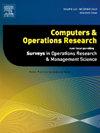考虑可变无人机速度和禁飞区的定时送货和按需取货的电动汽车-无人机路线问题
IF 4.1
2区 工程技术
Q2 COMPUTER SCIENCE, INTERDISCIPLINARY APPLICATIONS
引用次数: 0
摘要
本文介绍了考虑可变无人机速度和禁飞区(tdevdrp - sop - vds - nz)的定时送货和按需取货的电动汽车-无人机路由问题,涉及多辆电动汽车(EV)和无人机(uav)在考虑时变电动汽车速度、可变无人机速度和禁飞区的情况下,为带截止日期的定时送货客户请求(sdcr)和按需取货客户请求(opcr)提供服务。针对tdevdrp - sop - vds - nz,建立了基于路线的马尔可夫决策过程(MDP)模型,并将静态电动汽车-无人机联合配送路线与在线OPCR插入相结合,提出了离线-在线启发式算法(OOHA)。实验结果显示,与完全信息情景相比,确定性情景的平均奖励减少了0.23%,确定性情景的平均奖励高于不确定性情景。OOHA优于两种基准算法,差距在- 6.57%到- 0.31%之间。随着动态程度的增加,奖励和OPCR接受率都会降低。当动态度从0.2上升到0.5时,奖励下降超过10%,而更高的可变性导致奖励增加。平均在线处理时间保持在0.2秒以下,使系统能够实时快速响应新的opcr。OOHA展示了跨不同客户发行版的强大稳定性。灵敏度分析表明,禁飞区数量的增加降低了无人机的奖励和opcr服务比例,特别是该比例下降了16%以上。无人机飞行速度的敏感性分析发现,可变无人机速度优于最大和最小速度,最大和最小速度导致无人机服务的opcr比例下降60%以上。与Gu et al.(2023)的模型相比,tdevdrp - sop - vds - nz的平均在线处理时间更长,但更符合实际分布。本文章由计算机程序翻译,如有差异,请以英文原文为准。
Time-dependent electric vehicle-drone routing problem for scheduled deliveries and on-demand pickups considering variable drone speeds and no-fly zones
This paper introduces the time-dependent electric vehicle-drone routing problem for scheduled deliveries and on-demand pickups considering variable drone speeds and no-fly zones (TDEVDRP-SDOP-VDS-NZ), involving multiple electric vehicles (EVs) and unmanned aerial vehicles (UAVs) to serve scheduled delivery customer requests (SDCRs) and on-demand pickup customer requests (OPCRs) with deadlines, while considering time-dependent EV speeds, variable drone speeds and no-fly zones. For TDEVDRP-SDOP-VDS-NZ, a route-based Markov decision process (MDP) model is formulated to maximize rewards, and the offline-online heuristic algorithm (OOHA) is proposed, combining the static EV-UAV joint delivery routes with online OPCR insertions. Experimental results show a 0.23 % decrease in average reward compared to the perfect-information counterpart, with deterministic scenarios achieving an average reward higher than uncertain scenarios. OOHA outperforms two benchmark algorithms, with gaps ranging from −6.57 % to −0.31 %. As the degree of dynamism increases, both rewards and OPCR acceptance ratios decrease. Rewards drop by over 10% when the degree of dynamism rises from 0.2 to 0.5, while higher variability leads to an increase in rewards. The average online processing time remains under 0.2 s, allowing the system to quickly respond to new OPCRs in real-time. OOHA demonstrates strong stability across different customer distributions. Sensitivity analysis reveals that an increase in the number of no-fly zones decreases both rewards and the ratio of OPCRs served by UAVs, particularly the ratio, which drops by over 16%. Sensitivity analysis of UAV flight speeds finds that variable drone speeds outperform maximum and minimum speeds, with maximum and minimum speeds leading to a more than 60% drop in the ratio of OPCRs served by UAVs. TDEVDRP-SDOP-VDS-NZ, although having a longer average online processing time compared to the model of Gu et al. (2023), is more in line with the actual distribution.
求助全文
通过发布文献求助,成功后即可免费获取论文全文。
去求助
来源期刊

Computers & Operations Research
工程技术-工程:工业
CiteScore
8.60
自引率
8.70%
发文量
292
审稿时长
8.5 months
期刊介绍:
Operations research and computers meet in a large number of scientific fields, many of which are of vital current concern to our troubled society. These include, among others, ecology, transportation, safety, reliability, urban planning, economics, inventory control, investment strategy and logistics (including reverse logistics). Computers & Operations Research provides an international forum for the application of computers and operations research techniques to problems in these and related fields.
 求助内容:
求助内容: 应助结果提醒方式:
应助结果提醒方式:


